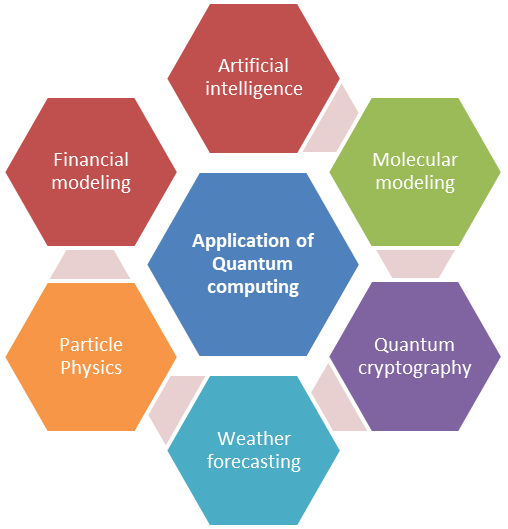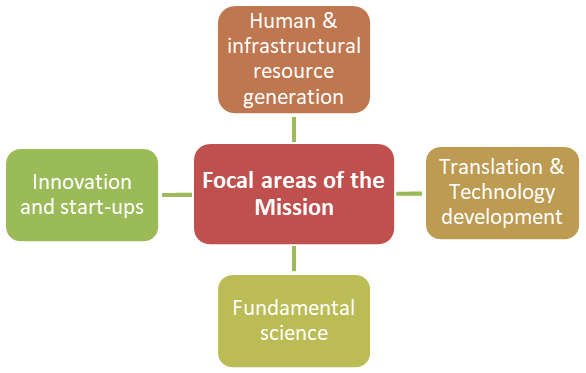Quantum Technology
2021 JAN 28
Mains >
Science and Technology > IT & Computers > Communication technology
IN NEWS:
- The Ministry of Electronics and Information Technology (MeitY) has announced the establishment of a Quantum Computing Applications Lab in partnership with Amazon Web Services (AWS).
WHAT IS QUANTUM TECHNOLOGY?
- In physics, a quantum is the minimum amount of any physical entity involved in an interaction.
- Quantum technology relies on the principles of quantum physics. It relies on the behavior of matter and energy at the atomic and subatomic level.
- Quantum technology is based on the ability to precisely control individual quantum systems.
APPLICATION OF QUANTUM TECHNOLOGY:
Its application extends to four broad areas:
I. Quantum computing:
- Quantum computing is the area of study focused on developing computer technology based on the principles of quantum theory.
- All computing systems rely on a fundamental ability to store and manipulate information. Current computers manipulate individual bits, which store information as binary 0 and 1 states.
- Quantum computers leverage quantum mechanical phenomena to manipulate information. To do this, they rely on quantum bits (or qubits), which can take any value between 0 and 1.
- Three quantum mechanical properties are used in quantum computing to manipulate the state of a qubit- superposition, entanglement, and interference.

II. Quantum simulation:
- A quantum simulator is a specially designed quantum computer constructed to simulate a certain process. A few experimental simulators have already attained quantum supremacy.
III. Quantum communication:
- Quantum technology offers a secure transmission of encryption keys via quantum communication.
- China has developed a quantum communication satellite named QUESS (also called Micius).
IV. Quantum sensing:
- Researchers are learning to use individual particles such as photons and electrons as sensors in measurements of forces, gravitation, electric fields etc.
BENEFITS OF QUANTUM TECHNOLOGY:
- Faster processing: Unlike traditional bit-based systems, quantum systems are exponentially faster. Eg: Google’s quantum computer ‘Sycamore’ reportedly did a task in 200 seconds that would have apparently taken a supercomputer 10,000 years to complete.
- Precision: The development of quantum sensors will lead to more powerful instruments and prediction tools. Eg: Molecular modeling can help develop precision drugs and therapeutics.
- Secure Communication: Quantum communication is often referred to as “unhackable.” China has already demonstrated secure quantum communication links between terrestrial stations and satellites.
- Boost Industrial revolution: Quantum computing technologies, like AI, cyber physical systems and financial modeling, will be an integral part of the upcoming fourth industrial revolution.
- Adapt to a climate uncertain future: Quantum technology can be deployed for modelling and accurate prediction of weather system. This in turn will help adapt to climate change, ensure food security etc.
INDIA AND QUANTUM TECHNOLOGY:
- National Mission on Quantum Technologies & Applications (NMQTA):
- To ensure the transition of quantum science and technology from a field of active interest in research laboratories to one that can be applied in day-to-day life.
- Help develop and bring quantum computers, secured communications through fiber and free space, quantum encryption and crypt-analysis and associated technologies within the reach of the country and help address India specific issues.
- Promoting advanced research in quantum science and technology
- Give a push to next generation transformative technologies such as quantum computers and computing, quantum communication, quantum key distribution, encryption, crypt analysis, quantum devices, quantum sensing, quantum materials, quantum clock etc.

- Quantum Enabled Science and Technology (QuST): It is a mission mode scheme under Interdisciplinary Cyber Physical Systems (ICPS) programme. It seeks to promote research and development activities in quantum technologies in the country.
CHALLENGES:
- Expensive: Due to their high sophistication and sensitivity, quantum level technologies are expensive to develop and maintain. For eg: A quantum simulator is a specially designed to simulate a certain process. It can therefore only solve a limited number of problems. If you want to solve other problems, you need to build a new quantum simulator, designed to solve those specific problems.
- Security concerns: certain aspects of classical cryptography would be jeopardized by quantum computing. Quantum computers can easily break the encryption keys of classical computers, thereby jeopardising sensitive information.
- Limited Research capacity: Globally, research in this area is about two decades old, but in India, serious experimental work has been under way for only about five years, and in a handful of locations.
- Absence of resources: The emerging technologies are resource intensive, both human as well as capital, like an academic ecosystem, physicists, computer scientists, material scientists and engineering systems. India lags in this front.
- Import of technology: India’s weakness in building hardware and manufacturing technology impedes efforts to implement theoretical ideas into real products.
- Lack of coordination: Quantum technology development in India is highly fragmented among various institutions and ministries. For eg: the ministry of electronics and information technology is interested in computing aspects; DRDO in encryption products and ISRO in satellite communication.
WAY FORWARD:
- Attracting and retaining human resources is essential to catch up scientifically with the international community, while quickly creating a vibrant intellectual environment to help attract top researchers.
- Indian industry should help quantum technologies become commercialised successfully. Governments must encourage industrial houses to take interest and reach out to Indian institutions with an existing presence in this emerging field.
- Ensuring coordination among ministries and institutions like DRDO is essential to integrate the research activity while ensuring expertise in relevant sub fields.
- The national mission can greatly help in fixing the resource problem. What is needed now is to foster a conducive ecosystem involving academia, industry and international collaboration.
PRACTICE QUESTION:
Q. Discuss the salient features of Quantum technology, with special reference to National Mission on Quantum Technologies & Applications?

